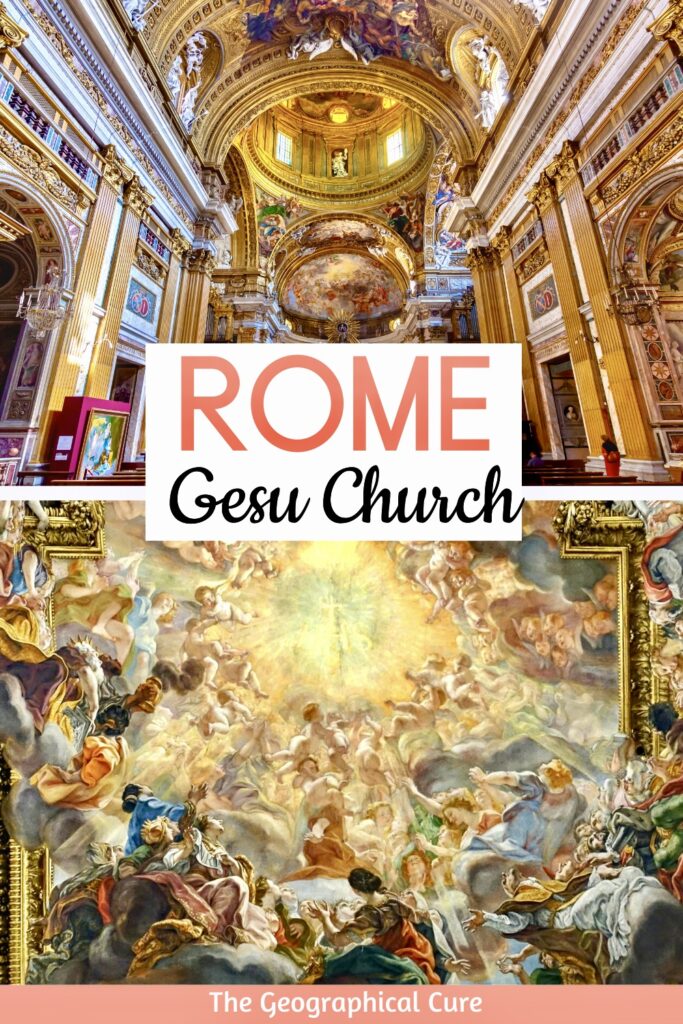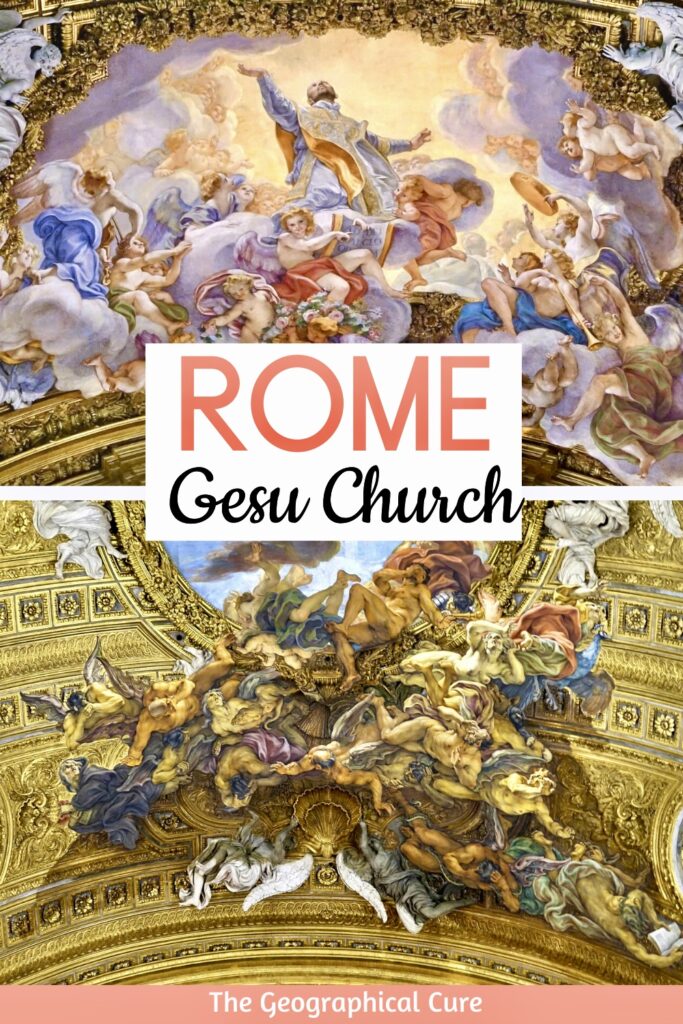The Gesù is the mother church of the Jesuit order and the best symbol of the Catholic Counter-Reformation. It’s packed with overblown Baroque art and under-appreciated history.
Completed in the late 16th century, it was designed by several prominent architects, including Giacomo Barozzi da Vignola and Giacomo della Porta.
The church is a set piece of the Baroque era. The Catholic Church encouraged artists to stir the emotions of the spectator. So the church is quite theatrical, designed to both amaze and strike a fear of God’s punishment.
You’ll see flying angels, swirling frescos, glowering sculptures, and gilded pilasters.
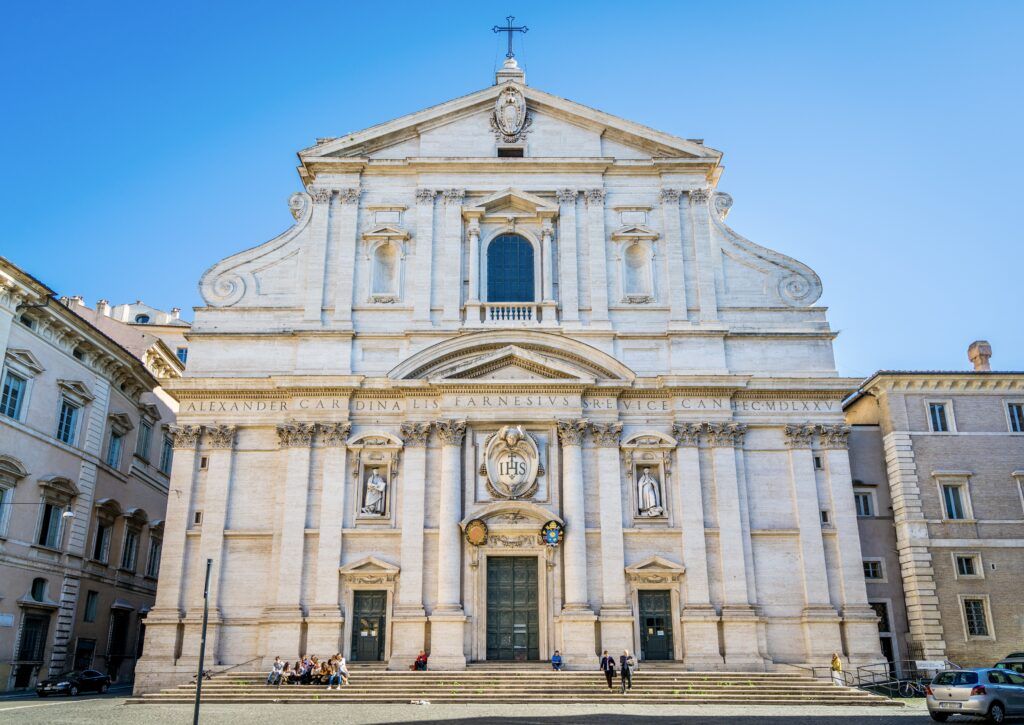
Guide To The Gesù Church: What To See
Here’s a rundown of the must see highlights of the Gesù.
Facade
The facade might look like a thousand other churches. But the Gesù was the first model for all the others.
At the time, its scroll-like shoulders were revolutionary. They broke up the rigid geometric forms of Renaissance architecture and signaled the coming of the Baroque.
The front is a ripple of travertine pilasters. In the architrave, you can see who financed the church and reaped the glory — the wealthy Farnese family.
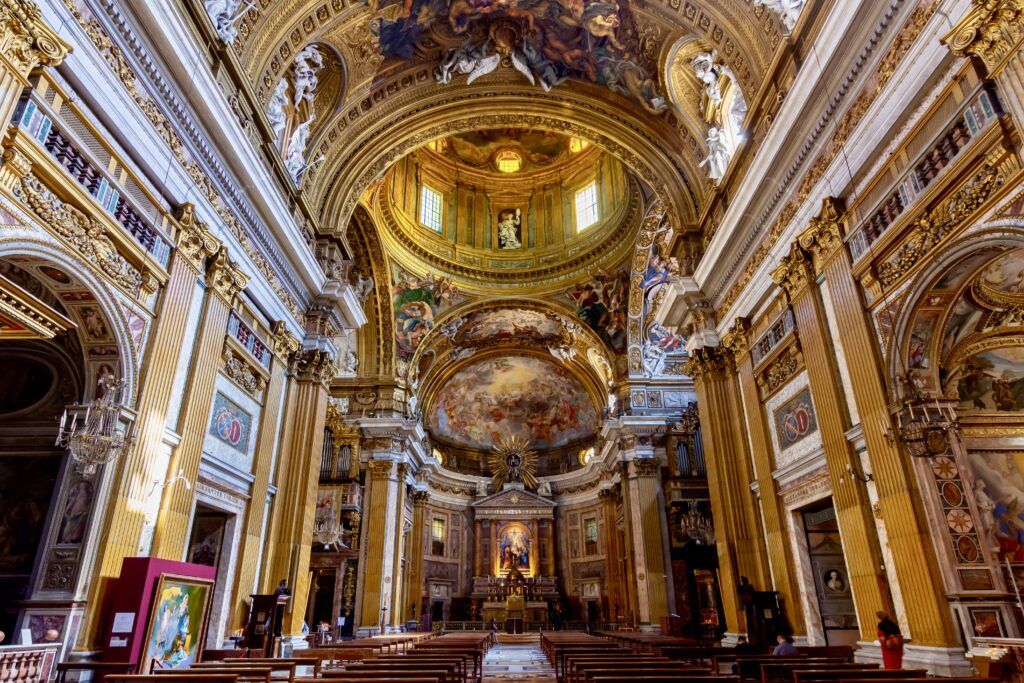
Nave
When the church was first built, the nave and the walls were white and unadorned. It was part of the theme of the Jesuit order — a vast and severe open plan.
The church was subsequently “Baroquified.” It’s crusted over with colorful, bombastic decoration from the 17th century, which emphatically announces the triumph of the church.
It’s a massive rectangular space, like one big lecture hall without the usual side aisles. There are side chapels in their place, each the same size and with a frescoed dome.
Gold marble fluted Corinthian pilasters are on each side of the nave separating the chapels. The focus is on the altar.
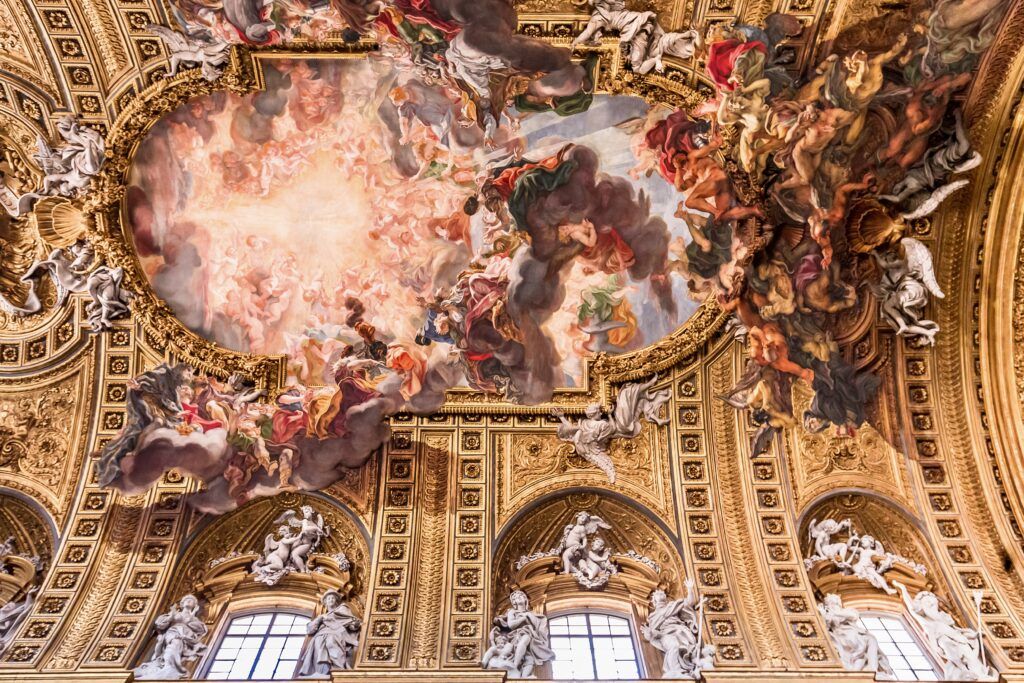
Ceiling Fresco
The Gesù’s stunning ceiling fresco is by Giovanni Battista Gaulli, also known as Baciccio. He was a protege of Bernini.
It’s an astonishing masterpiece of illusionistic painting, and the highlight of the interior. The title is The Triumph in the Name of Jesus.
The seemingly 3D fresco depicts a dynamic scene of angels, light, and clouds. They swirl around the central IHS monogram, in golden light, the symbol of the Holy Name of Jesus.
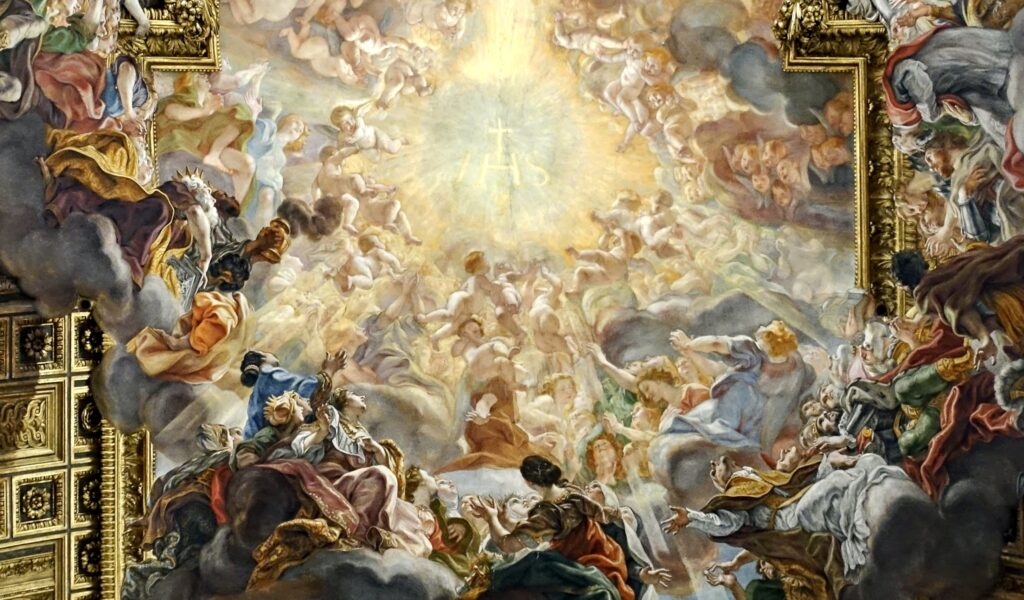
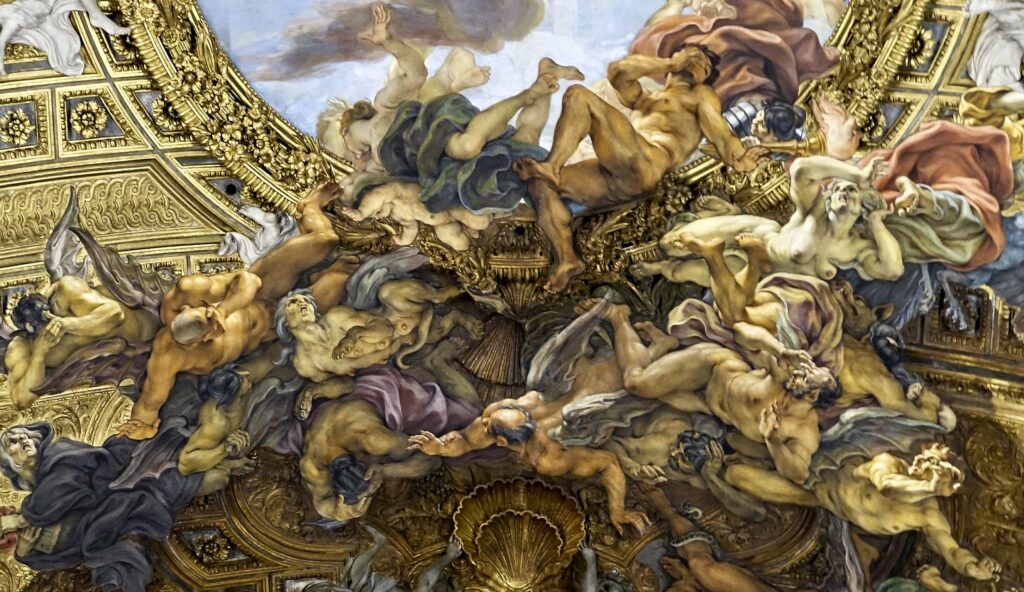
Around this central symbol, a twisted tangle of bodies — the damned — are shown being cast down into the shadows, while the blessed ascend into the heavenly light.
The bodies even spill over the edge of the painting’s frame on their way to hell. It’s a tumultuous scene with storm clouds.
The moral is clear. Hell is the fate of Protestant heretics who dare to pervert the true teachings of Jesus.
There are mirrors in place so that you can study the fresco closely.
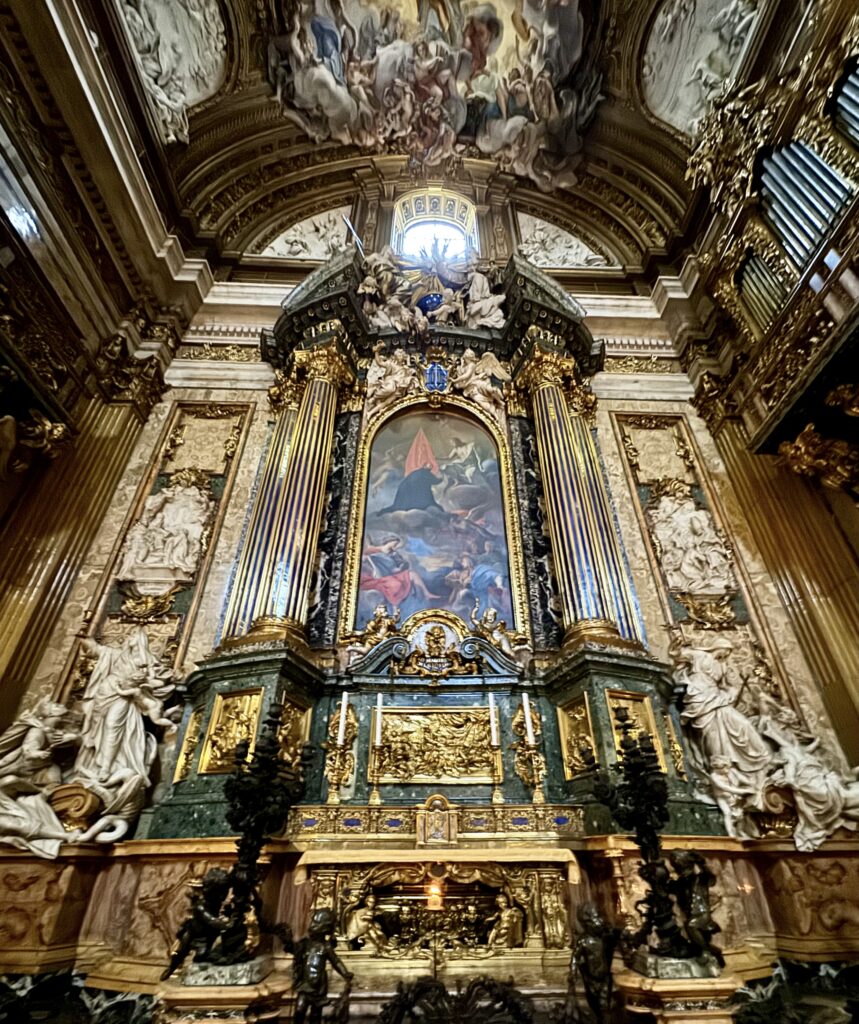
Tomb & Altarpiece of St. Ignatius of Loyola
A big altarpiece with towering columns and statues marks the burial place of St. Ignatius, who founded the Jesuit order.
It’s covered in silver, gold, green marble, and lapis lazuli. Once wonders if the simple saint would’ve appreciated all the glitz.
In the center, you’ll see a painting by Andrea Posso of Ignatius receiving his call from Christ. To each side, are large sculptural groups.
One is Religion Overthrowing Heresy. It shows the church as an angry man about to whip miserable protestants. To the left is similar one of Ignatius.
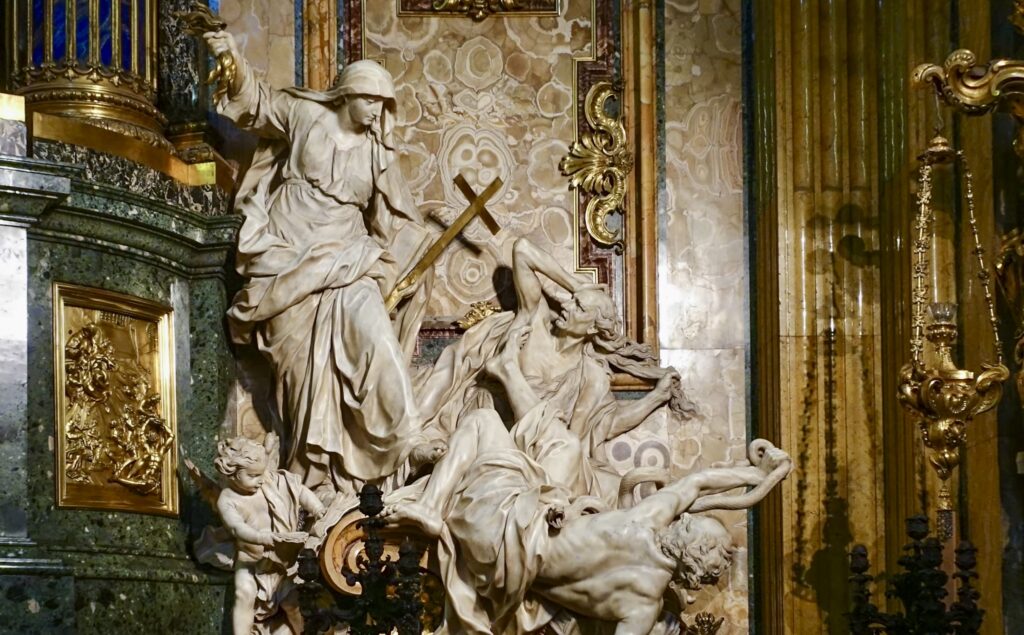
They underscore the Jesuit’s zeal for a rather unfeeling dedication to truth and uncompromising obedience to the church.
Behind the painting there is a gleaming over-the-top statue of the saint, spreading his arms wide.
You can only see it if you attend the 5:30 pm mass. Then, in dramatic fashion, they lower the painting and strut out the statue.
Ignatius’ body lies in a small coffin.
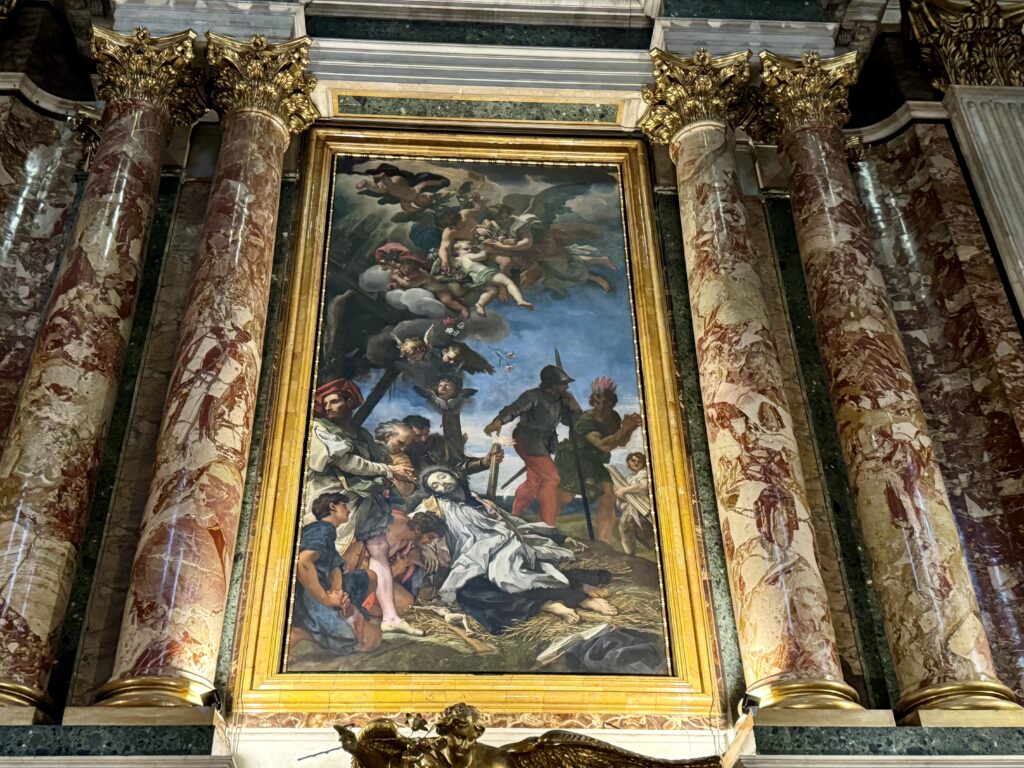
Tomb & Altarpiece of St. Francis Xavier
This was also the age of discovery, when Spain and Portugal were colonizing and Christianizing the world. Francis Xavier joined up and headed out to convert the heathens.
He was on the road for a decade trying to teach a monotheistic religion to polytheists. But tireless evangelizing paid off, making Catholicism a worldwide religion.
The chapel was designed by Pietro da Cortona. It has a high plinth of colored marble and four red veined marble Corinthian columns.
The altar painting depicts St. Xavier dying abroad. A stucco relief shows him being carried to heaven by angels. On the altar step is a silver reliquary that holds the saint’s right forearm.
Chapel of the Angels
This chapel boasts four paintings by Federico Zuccaro — Angels in Adoration of the Holy Trinity, Coronation of the Virgin Mary, Fall of the Rebel Angels, and Angels Delivering Souls from Purgatory.
There are statues of angels in the niches, which are by Flaminio Vacca and Silla Longhi.
Four marble panels feature carved festoons of fruit and vegetables. They came from the ancient Baths of Titus. They now sport winged heads of cherubs, from the 1600s, to make the secular work appear more sacred.
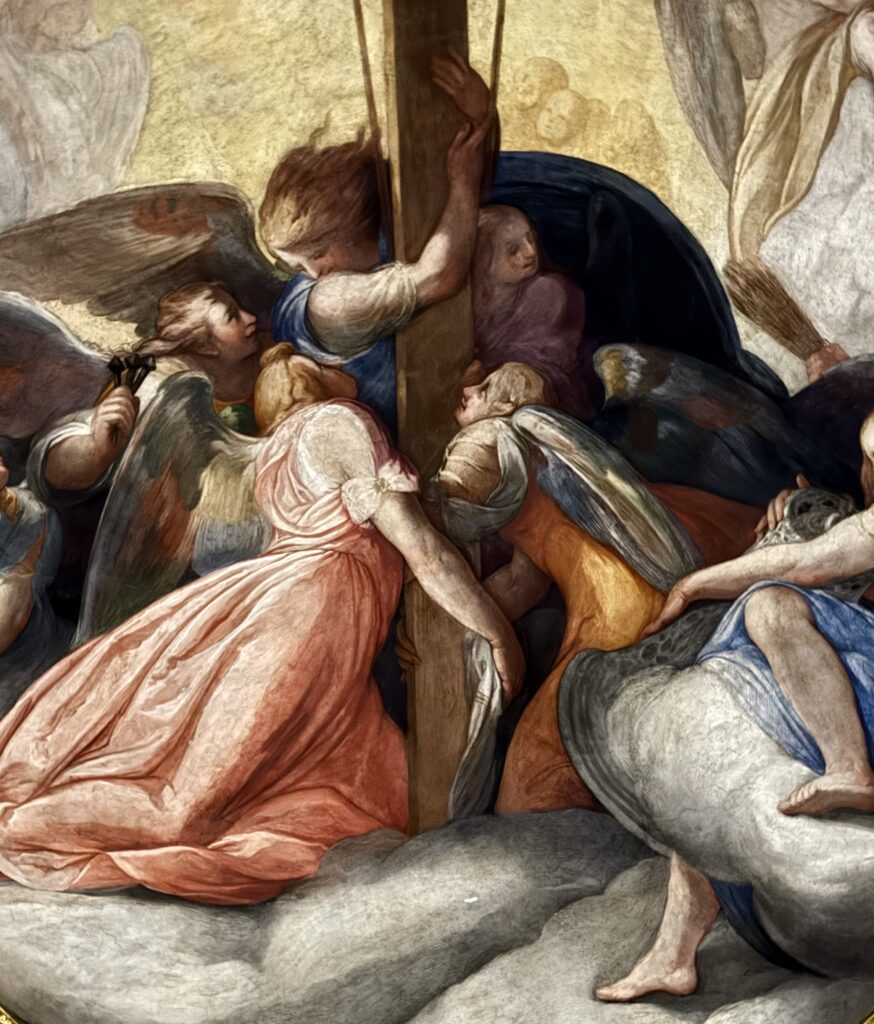
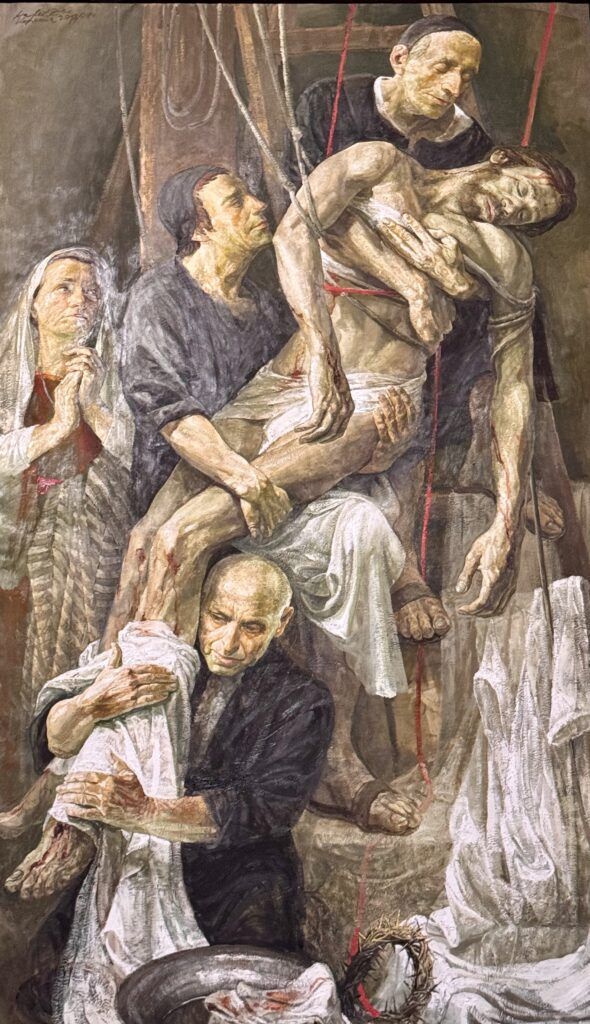
Chapel of the Passion
The Chapel of the Passion was designed by Gaspare Celio. As it name suggests, it depicts scenes of Christ’s passion.
As you enter, you’re greeted by prophets Isaiah and Zachariah, urging you to “see thy teacher” and “look on him whom they have pierced.”
Around the altar, six depictions of Christ during the passion invite contemplation. Four are on pillars.
They show him exposed to the public, enduring the scorn, mockery, and condemnation of an oblivious crowd.
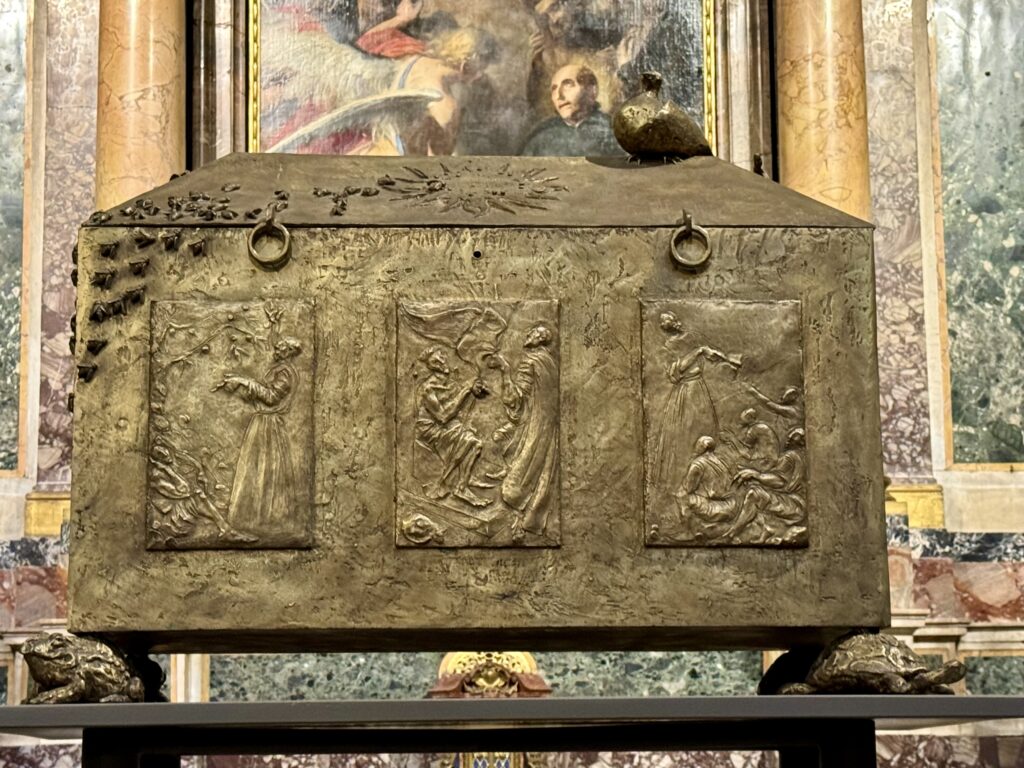
Chest of Relics
As the mother church of the Jesuit order, the church preserves important relics. Once kept in separate reliquaries, they church decided to emphasis the unity of the body of society and place them in one chest.
Italian sculpture Maestro Ernesto Lasagna created the piece. It rests on four feet in the form of animals representing evil and temptation.
On the main sides of the chest are six scenes, including ones of St. Ignatius. The top bears olive branches, symbolizing peace and happiness.
On the very tip top is a dove. It symbolizes the Holy Spirit, the source of holiness.
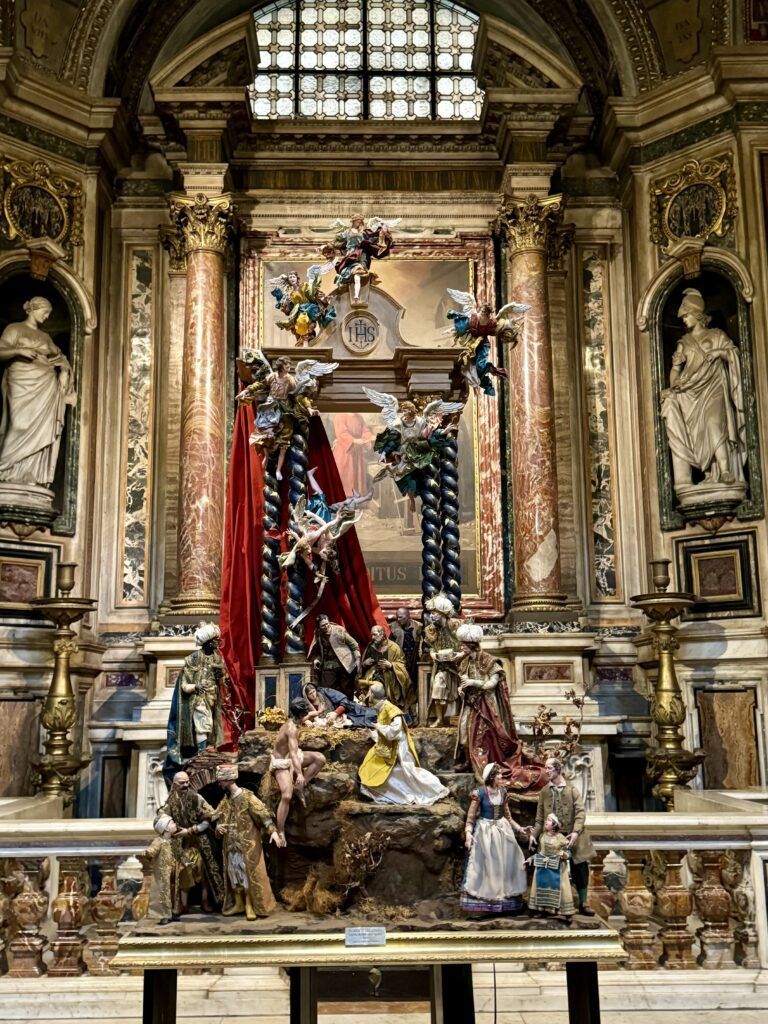
Jesuit Nativity Scene
If you drop by the church in December, don’t miss the Jesuit Nativity Scene. This elaborate creation is the work of Neapolitan sculptor Ulderico Pinfildi. It’s intended to convey a message of a hope and joy.
There are over 1500 pieces, all meticulously assembled over 50 hours. It’s a theatrical display centered around St. Ignatius.
You’ll find Mary, visibly weary from childbirth, cradling the newborn Jesus, with Joseph at her side. In the center, St. Ignatius lays down his sword to kneel in reverence before the nativity.
And for a touch of authenticity, all the traditional nativity figures are dressed in Neapolitan costumes. It’s a sight to behold!
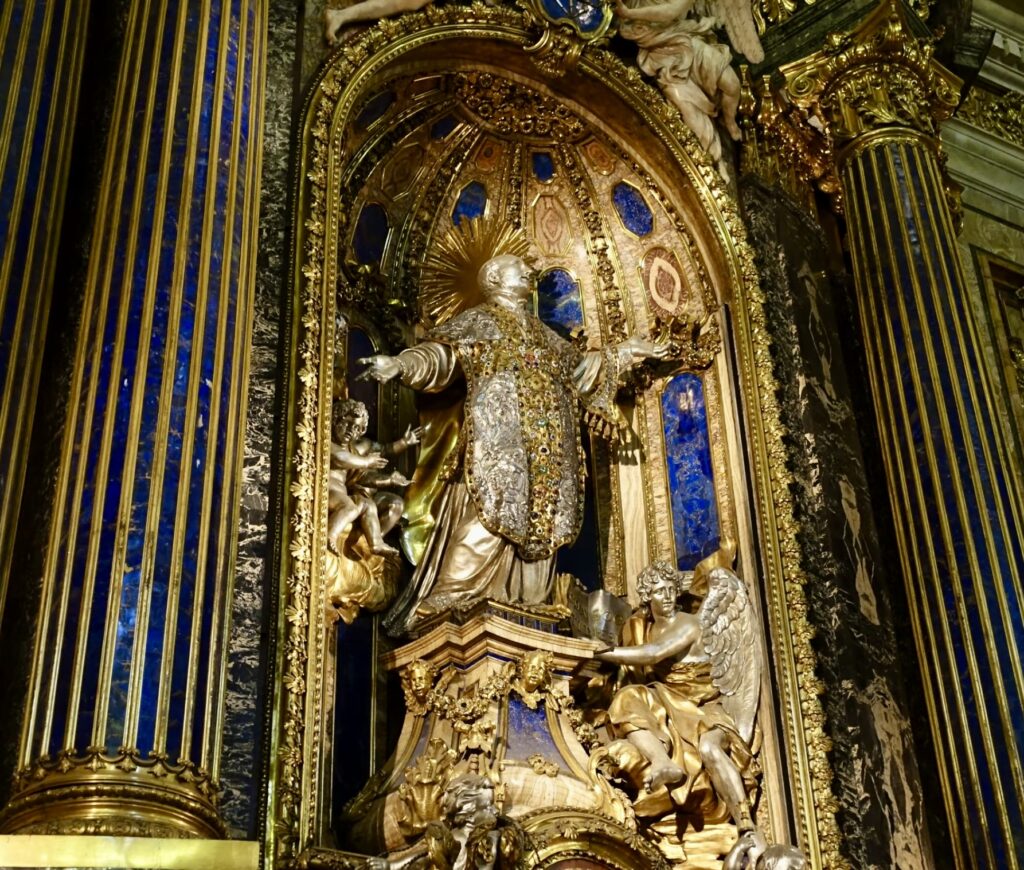
Practical Guide & Tips For The Gesù Church
Address: Piazza del Gesù
Hours: Open daily 7:30 am to 12:40 pm & 4:00 pm to 7:30 pm.Keep in mind the rather long closure in the middle of the day when planning your visit.
Tickets: Admission is free.
Is The Gesù Church Worth Visiting?
I think it’s worth popping into for a half hour or so, especially if you like Baroque architecture. It’s one of the most ostentatious churches in Rome and feels like a time capsule of the era.
I advise arriving before 5:30 pm so that you can witness the unveiling of the St. Ignatius statue.
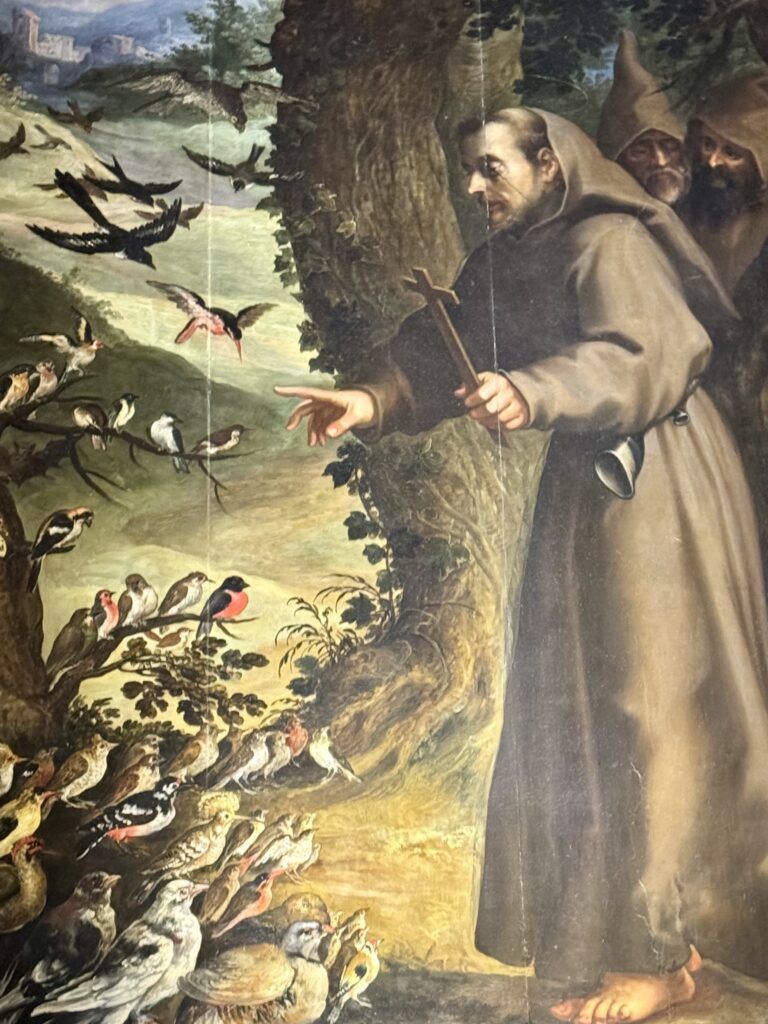
You could combine it with a visit to the Church of Santa Andrea della Fratte, Crypta Balbi, Largo di Torre Argentina, Piazza Venezia, Palazzo Braschi, the Giovanni Barracco Museum.
I hope you’ve enjoyed my guide to the Gesù Church. You may find these other Rome travel guides useful.
- 8 ways to spend 1 day in Rome
- 3 day itinerary for Rome
- 4 day itinerary for Rome
- 5 day itinerary for Rome
- Best museums in Rome
- Hidden gems in Rome
- Archaeological sites in Rome
- Guide to the Borghese Gallery
- Guide to Palatine Hill
- Guide to the Roman Forum
- Guide to the Colosseum
Pin it for later.

